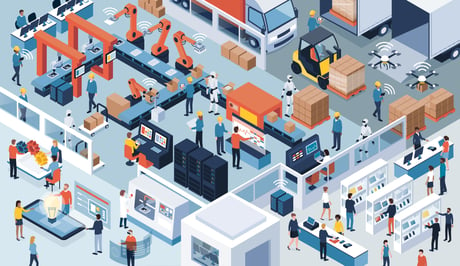
The world of ERP is rapidly changing with 2024 right around the corner. Businesses have been scrambling to implement innovative solutions and strategies to stay ahead of their competitors. But which companies will emerge as winners, and what exciting ERP news is on the horizon? In this special mini-series, ERP Advisors Group’s Founder and Managing Principal, Shawn Windle, and Digital Marketing Manager, Rebekah McCabe, showcase the upcoming ERP trends for manufacturers and distributors in 2024 and uncover their predictions for the upcoming year.
ERP Trends for Manufacturers
Introduction
The manufacturing industry continues to evolve, with outside factors compounding in recent years to transform the way manufacturers evaluate and select software solutions. Transformation will continue into the new year, opening the door for manufacturers to harness the power of emerging technologies to improve their operations. This industry review addresses the pain points, opportunities, and reminders manufacturers should consider in 2024.
Major Manufacturing Pain Points
When COVID-19 caused an unexpected pandemic of disruptions in the supply chain in 2020, material requirements planning became volatile and inconsistent and therefore was a major pain point for manufacturers. A backlog of unfulfillable orders developed. Unfortunately, once the backlog was caught up, demand had suddenly waned, but suppliers and producers suddenly had more raw materials than they knew what to do with. Significant assets were tied up in unmoving supplies and inventory. As a result, tension built up until the market was able to stabilize once again. After these major disruptions, many manufacturers realized they needed more advanced technology to automate planning and make better predictions for future demand.
The second pain point revolves around master data management. Whether it’s assigning numbers to raw materials for organization in the system, analyzing work in progress (WIP), or tracking finished goods, manufacturers are finding they need insight across all the data in their product’s lifecycle. Many manufacturers struggle to manage all their data due to disjointed systems and processes. Manufacturers considering an ERP upgrade can resolve the “spaghetti bowl” of applications that comprise their applications ecosystem, which will simplify duplication of data entry or integrations of information across multiple applications.
How the Manufacturing industry was impacted in 2023
2023 was a “wait-and-see” year for the manufacturing industry, specifically with artificial intelligence (AI). High tech industries, like software and professional services, have been utilizing AI to help with business automation for years. However, manufacturers tend to wait to implement new technology until it has become more stable, so as not to disrupt proven processes.
Manufacturers who still run legacy ERP software that is approaching end-of-life may have limited or no support from the vendor altogether. Manufacturers on legacy software continued to weigh the benefit of legacy upgrades to the newer “cloud” version or consider altogether new ERP options this past year. We regularly meet with manufacturers who have been using the same ERP for 15, 20, 25, 30, or more years. Therefore, we see that the industry is still ripe for new core ERP transactional systems which inevitably will displace systems that eventually can no longer run on current infrastructure including servers or operating systems.
What tools will manufacturers leverage in 2024?
In the new year, many manufacturers will continue to switch from their legacy-based systems to a cloud-based ERP. Manufacturers have several moving parts within the business, so it’s vital to have the support to ensure the ERP is meeting all its needs. However, manufacturers will not win with AI, at least not yet. It won’t make an immediate impact on this industry, but there is a strong possibility it will become a vital tool in the near future.
The #1 Reminder for manufacturers before jumpstarting 2024
Understanding your needs is more important than ever. With so many options available on the market that sometimes offer only minor differences in functionality, it is easier to choose the wrong solution - a common factor in ERP failures. Businesses must start small and continue to increase their expectations over time, or they risk unwarranted disappointment. Understanding the needs of the business ensures two things: it aligns the vendor to meet those needs and enables the implementation partner to become a better resource for configuring the ERP. When these pieces are in place, a successful go-live will soon follow.
conclusion
The manufacturing industry will see continuous improvement through the rest of this year and into the next. Manufacturers are up against the need for better planning tools and access to master data management, obstacles that will continue into 2024. As manufacturers march forward, success will be found in harnessing the functionality available in manufacturing specific and micro-vertical tools. Overall, manufacturers should be evaluating their processes to identify opportunities for automation and process improvement because companies that can evolve with the market will be the winners in the coming years.
ERP Trends for Distributors
Introduction
Sophisticated software and ERP technologies have improved overall business productivity for wholesale distributors over the last several decades. However, access to rich, industry-specific technology does not relieve distributors of the obstacles that arise with purchasing and successfully implementing ERP. In this industry review, we unveil opportunities for relieving typical distributors’ pain points while making predictions for distributors in the new year.
Distribution disruptors
Distributors who neglect to change or upgrade their ERP may find themselves fighting an uphill battle to hire new people due to running outdated systems. This can exacerbate difficulty in finding new talent amid recent labor shortages. Many companies have been running on the same system for 20 to 30 years, and new employees in the workforce may struggle with being ‘downgraded’ to older, slower software compared to the advanced technology they have become accustomed to, even in college or on their personal devices.
Selecting a new ERP at the right time can help combat market conditions and assist distributors in hiring and retaining new employees. Providing employees with advanced and simplified software not only improves their productivity but also their morale and desire to stay at their jobs. Despite the disruptions to the business, an ERP implementation can provide a strategic platform that serves the customers, employees, and vendors, possibly disrupting a stagnant micro-vertical that has not experienced recent technological advances.
Data analytics will differentiate distributors
Accessible, actionable data will become the driving force for the distribution industry in the coming years. Distributors store significant amounts of transactional data. However, creating insightful reports requires storing transactional data in repositories such as data warehouses, data lakes, and even data lakehouses. Reporting tools can then query the data and provide key operational reporting not available within core ERPs. Distributors who leverage this information to make important business decisions will eclipse their competitors because they can barely keep their legacy transactional processing systems operational on legacy infrastructure, much less set up key reports for driving important business operational decisions. As a result, distribution companies need a strong ERP in place to capture their core data so it can be moved into data repositories for creating key reports.
technology factors to leverage in 2024
Simplicity is the undisputed winner. The easier and more automated distributors’ processes are, the greater productivity and success they will achieve moving forward. Distributors must be aware of artificial intelligence (AI), but not worry about their next steps regarding this emerging trend.
ERP software vendors will use AI to build new applications and integrate it throughout their preexisting technology stacks, which will significantly reduce the cost of developing and deploying software solutions. This strategy will help the apps get into a stronger, more cost-effective, and operationally focused position. And because the distribution industry is extremely cost-conscious, they should be paying close attention to vendors’ practices and new ideas as AI continues to develop.
conclusion
The distribution industry is embracing its strategies and critical thinking heading into the new year. Several factors will help shape this industry’s future such as AI, ERP vendor strategies, and turnover of ownership, ultimately enabling the industry to grow as technology advances. Distributors that keep simplicity and cost-effectiveness at the forefront, while ensuring their technology strategy is shored up, potentially with a new ERP and a data analytics solution, are the most likely to achieve success in the new year.






